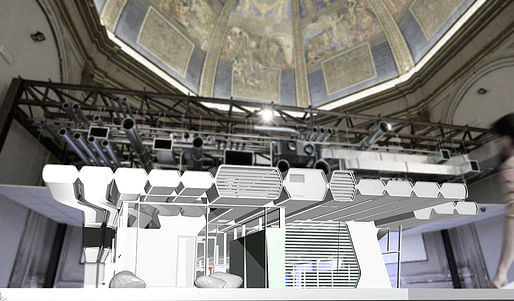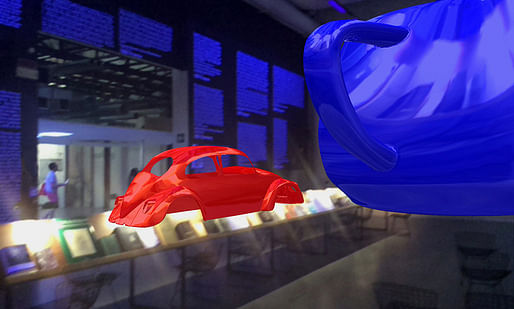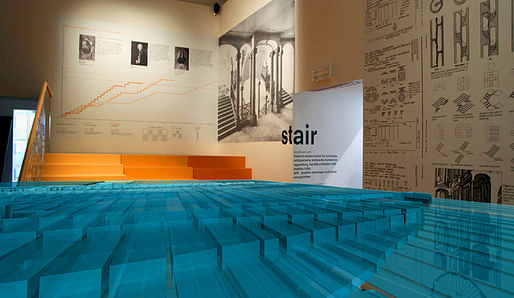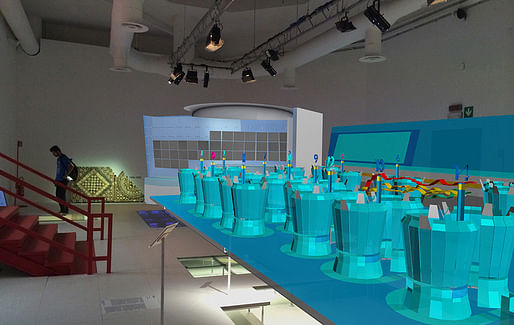
Hacking an architecture exhibition through augmented reality? Yes, there's an app for that. "Project Source Code" is a digital guerrilla-style exhibition created by architect/artist/researcher Güvenç Özel that lets mobile-device users "hack" key works in Rem Koolhaas' "Elements of Architecture" exhibit currently at the 2014 Venice Biennale. Blending digital and physical space, the project is deemed to be the first to use augmented reality on a live exhibition and also the first time that raw 3D architectural models are treated as exhibition pieces.
Ozel's selection includes 6 pioneering works he directly acquired (with prior approval) from contemporary architects and designers known for their use of digital design techniques. This includes Asymptote Architecture, Greg Lynn FORM, Neil M. Denari Architects, and Oosterhuis_Lénárd.
Ozel fully explains his project in the info he provided below:
PROJECT SOURCE CODE
"In the field of computer science, SOURCE CODE refers to a set of instructions that demystifies how a specific computer program operates.
In his exhibition “Elements of Architecture” for the 2014 Venice Architecture Biennale, despite the seemingly broad scope of his curatorial efforts, Rem Koolhaas chooses to exclude one of the most fundamental elements of contemporary spatial production: the digital. The methodological, social and perceptual potentials and problems of the digital has over the years become one of the primary concerns of architectural discourse. This intervention intends to reveal certain key moments in the evolution of digital discourse in architecture- i.e. the SOURCE CODE- which influence both the material and conceptual dynamics of contemporary architectural thinking and production."

"How is the Exhibition Hacked?
By downloading the free augmented reality (AR) application titled “Augment” (available in the IOS and Android app stores), participants view 3D models of selected projects by pointing their mobile devices at certain images found in the “Elements of Architecture” exhibition. A map accompanying SOURCE CODE serves as a guide;; it identifies the locations of the images in the physical exhibition that function as “trackers” for the featured digital models. This project can be thought of as a new way of merging the digital and physical worlds in a curatorial context, embedding digital information in physical space, questioning the notions of control, intellectual agency and modes of communicating architectural information.
Moreover, architects seem to be the only artists working in the digital medium that do not share files with their colleagues in the same way that other disciplines do, such as electronic music, digital art and the like. The Augmented Reality tool problematizes this notion and de-mystifies the digital production, reproduction and distribution of architecture as information and media. To this point, the works exhibited were acquired directly as 3D Models from the architects and designers that conceived them;; uploaded into the web as historic artifacts serving as experiential bits of information."
"WHY IS THIS EXHIBITION HACKED?
In 1851, when Gottfried Semper published his seminal work, “Four Elements of Architecture,” he created categories of architectural object-types based on their anthropological significance: the hearth, the roof, the enclosure and the mound. These categories also had material and technique-specific origins, which helped him draw meaningful lineages between the contemporary applications of then, using the evolution of technology as an organizing principle. Since then, some of these categories have gone through significant transformation or have been eliminated entirely as a result of changes in economic, material and social systems. The hearth, for example, having lost its traditional anthropological significance, is now superfluous and has been replaced with HVAC equipment.
Koolhaas’s objective to breathe new life into such displaced categories and simultaneously define new ones of his own is a much welcome attempt. Nevertheless, Koolhaas’ newly amended list is curiously plagued with category mistakes that convolutes rather than clarifies the social significance of material based anthropologies. There are certain elements that lack any historical account, sub-categories presented as categories, and some very fundamental categories completely excluded.
For example the escalator, getting its own category, is merely a mechanized stair. The toilet is an industrial design object that has little to no influence on design of spaces around it. (Perhaps Koolhaas aims to seduce by provocation rather than relevance.) Window and façade can no longer be defined as two distinct categories. And the column, one of the most prominent and historically rooted elements of architecture, has been completely excluded. The list goes on. The methodology of creating a more contemporary list of “Elements of Architecture” begs for much clarification.
BIENNALE WITHOUT ARCHITECTURE?
Perhaps one explanation to this curatorial conundrum lies in the marketing pitch of the exhibition- “Architecture without Architects”. By purposefully excluding disciplinary concerns of architects, Koolhaas not only chooses to ignore the way architects work, but what they eventually produce as well. Spatial systems are represented as casually placed historic artifacts and styrofoam set pieces, devoid of context, or as highly curated, mannerist graphic design environments that take their cues from the “Fundamentals” catalogue rather than the physical and interactive potential of an exhibition itself. By fetishizing functional parameters through his generational lens that measures the power of architects by their control over the built environment rather than their contribution to it, Koolhaas enforces an outmoded assumption that human experience of space is limited by management, distribution and organization of materials rather than knowledge and perception. It also announces the end of the architecture exhibition as a legible platform for disciplinary dialogue.
By alienating architects, his primary audience, as the distant observers, Koolhaas aims to survive as the sole perpetrator of architecture. Koolhaas’ failure to produce a coherent narrative for his exhibition is as good a moment as any to announce the declining dominance of the baby boomer generation, which has long masqueraded control as intellectual agency, contradiction as diversity and irony as social critique. Radical juxtaposition, once catalogued, is no longer a legible critical instrument. It has been a long time since we positioned architecture as a body of knowledge rather than a collection of documented artifacts.
Instead of cataloging architects or their “final products” as fragments standing in for the ultimate embodiment of their achievements, SOURCE CODE uses augmented reality to convey information through experience. Their construction is meant to exist in the world of ideas. If the “Fundamentals” Biennale is symptomatic of our lack of understanding of the tools that we have created to organize information and matter, then SOURCE CODE is symbiotic to this notion rather than reactionary. However, it is not intended to draw meaning through juxtaposition with the current exhibition at the expense of its autonomy and superposition. It merely exists as an invisible reality.
WHY INSERT SOMETHING THAT IS PURPOSEFULLY OMITTED?
In Fundamentals, the absence of architects and their methods of working results with absence of architecture. Early Modernist architects, well documented in “Fundamentals” and illustrated in many national pavilions of the Biennale, define modernism as an attitude to concern oneself with contemporary ideas, methods and material strategies. When viewed from this perspective, a project that explores mass customization, interactivity, digital design and fabrication is more modern than a project in the International Style.
Therefore the content that is included in the SOURCE CODE are primarily projects that focus on the relationship between technology, form, use and representation, highlighting important realizations in disciplinary evolution. SOURCE CODE starts with tracing the origins of translation between the digital and the physical worlds, a paradigm so fundamental to contemporary understanding of space, society and their interaction through technology. There is no longer a difference between information and representation, as what we understand as reality now is constructed so commonly through a synthesis of the physical and the virtual. They have become ubiquitously perceptual, therefore actual."
FEATURED PROJECTS

PROJECT 1
Corrugated Duct House, 1998
Neil M. Denari Architects
"Initially designed as an experimental proposal for the desert climate of Coachella Valley in Palm Springs, California, Corrugated Duct House explores a holistic relationship between climate technology and architectural typology. The unavoidable presence of air conditioning serves as a fundamental design parameter that determines the morphology of the ceiling and the roof, where technological and material conditions drive the formal organization and techniques of construction. The HVAC equipment, instead of being completely autonomous from the ceiling plane, influences the interior surfaces while allowing for a climatic optimization. The symmetrical corrugation of the roof/ceiling not only creates HVAC plenums but also structural depth. As the corrugations twist and turn to form columns, interior partitions and built-in furniture, they also create localized climatic zones since the cool air flows through the entire system. In this proposal, the HVAC equipment is neither completely hidden, as demonstrated in the mock-up of dropped ceiling on your right, nor celebrated and fetishized. It is opportunistically utilized to create a synthesized system of formal, technological, structural and aesthetic logics."

PROJECT 2
The VW Beetle Shell, 1967, and The Utah Teapot, 1975
Ivan Sutherland and Martin Newell
"The collection of objects presented here trace the origins of how objects were first represented in the digital realm in 20th Century. Although first computer graphics date back from the objects presented here, the significance of these works, primarily executed at University of Utah Department of Computer Science, stem from them being the first accurate representations of physical objects translated into the digital realm, therefore setting the standard of mathematical definitions of digital objects still being used today.
The VW Beetle Shell, 1967
Conceived by Ivan Sutherland and his students in University of Utah, the VW Beetle Shell is the first digitized 3D model of an object. By mapping out and subdividing polygons directly onto Sutherland’s wife’s VW Beetle, the team measured every drawn polygon by yardsticks, and entered these datasets into Sutherland’s programs as Cartasian vertices. The model was used for testing out early visualization and rendering techniques, and the physical measuring method become directly translated into the digital representation of objects we use now. Later on, Bui Tuong Phong created the first computer generated image in history by using this dataset. The animated 3D model you see around you is a file dating 1982, making it most likely a very accurate version of the initial set of vertices.
The Utah Teapot, 1975
The most ubiquitous object in digital representation is the Utah teapot. Modeled by University of Utah researcher Martin Newell in 1975, the geometry was based on a Melitta teapot he had in his home. It is the quintessential reference object in digital modeling, due to its fairly simple yet variable shape. The process Newell followed was hand sketching the teapot first, and then measuring these drawings to construct the 3D model through a set of relational vertices. The model exhibited here is the reproduction of the first modeled geometry based on the exact control vertices of the original teapot."

PROJECT 3
Saltwater Pavilion, 1997
Oosterhuis_Lénárd
"The saltwater Pavilion is the first fully occupiable space with software controlled interactive and user responsive qualities. Many of the traditional architectural typologies are merged with each other, where the differentiation of floor, wall and ceiling is continuously blurred. Fenestration is largely omitted in order to create a fully computer controlled lighting and ventilation environment. The transforming ambience is achieved through a complex lighting strategy that tracks the occupants and responds accordingly, as well as kinetic inflatable elements that change the physical boundaries of the interior space through systems in motion;; regulating circulation, views and natural lighting accordingly. The Saltwater Pavilion overlays digital and physical space into one synthesized whole. By merging simulation and matter in motion, The Saltwater Pavilion becomes the pioneering space where material and virtual realties are experienced as one. In this digital model, you experience the original design of the pavilion ceiling in 1:10 scale, as well as an overall massing model of the pavilion used for fabrication and construction."

PROJECT 4
Spreebogen Master Plan, 1993
Roberge, Rudy, Hoffman, Koebel
"This early digital project was a part of group work that Heather Roberge of Mumur completed while she was still a student. It was a retroactive proposal for an international competition for the new seat of Germany’s Bundestag, held in 1992 following the fall of the Berlin Wall and Germany’s reunification. Sited north of the Tiergarten, this proposal envisioned the Spreebogen as a mixture of landscape and governmental office building elements merged into one. The project interweaves landscape park, government buildings and the urban ground with a series of linear canals diffusing the boundary condition of the river Spree. This figure/figure organization predates an influential moment in architectural discourse in late 90s where landscape and building forms fused together as a continuous yet heterogeneous datum. Early theoretical principles of such design methodology were illustrated in Stan Allen’s influential essay “Field Conditions” in 1985 and later exemplified in built projects such as the Yokohama Port Terminal by FOA in 2001. Project by Heather Roberge, Phil Rudy, Stephen Hoffman and Joe Koelbel under the direction of Jeffrey Kipnis and Bahram Shirdel."

PROJECT 5
Virtual Trading Floor, 1999
Asymptote Architecture
"Virtual Trading Floor is the first fully functional virtual reality environment for business applications. Initiated by New York Stock Exchange, the project is seminal in the sense that it is the first ever fully operational digital space that is practical;; a condition where representation becomes reality. The animated visualization allows the employees of the stock exchange to have an overview of the operations of the system through architectural representation. The continuous data streams are constantly updated in the digital model, turning it into a three-dimensional control center. Besides the virtual space of the project, Asymptote also designed the room in which the staff accesses this information. The duality of the digital and the physical spaces creates a continuum between the physical and the virtual through a common architectural language. Behind you, you will see the actual digital model of the virtual trading floor, as well as the digital massing model of the physical room built in NYSE in which the Virtual Floor is accessed."

PROJECT 6
Embryological House, 1997
Greg Lynn FORM
"The Embryological House is perhaps the first study on the concept of mass customization. As a culmination of Lynn’s interest in calculus based geometries and biological design models, the project calls into question the aesthetic, technological and functional conventions of Modernism. Importing programmatically determined control points into animation software Maya, Lynn generated an animated meta-model (blendshape) where numerous shells with different morphologies can be extracted. Between the 1997 and 2002, Lynn produced a number of physical and digital versions of the project through variations of fabrication, animation and material techniques. In this exhibition, you will find the original blend-shape diagrams in motion, along with 4 models extracted and architecturalized in detail through façade, fenestration and material strategies consistent with the geometric principles of the software generated form."
CREDITS:
PROJECT SOURCE CODE:
Hacking the Venice Architecture Biennale 2014 through Augmented Reality
Project Website: www.biennalehacked.com, www.project-sourcecode.com
Conceived and Executed by:
GÜVENÇ ÖZEL
ozeloffice.com
#biennalehacked
#projectsourcecode
#guvencozel
This intervention is made possible by the in-kind support of:
ASYMPTOTE ARCHITECTURE
GREG LYNN FORM
MURMUR
NEIL M. DENARI ARCHITECTS
OOSTERHUIS_LÉNÁRD
Archival Support Provided by:
CANADIAN CENTRE FOR ARCHITECTURE
Production Support by:
CHAMPIONS OF CULTURE
BIO:
Güvenç Özel is an architect, artist and researcher. He is the Technology Director of IDEAS, a multidisciplinary research and development platform in UCLA Department of Architecture and Urban Design, and the principal of Ozel Office, an interdisciplinary design practice located in Los Angeles, USA. His work is at the intersection of architecture, technology, visual arts and research on urban culture. Özel studied architecture, sculpture, and philosophy in Bennington College, USA.
In addition, he holds a Masters of Architecture degree from Yale University, where he graduated with multiple awards. His projects were exhibited in museums and galleries around the world, including Istanbul Museum of Modern Art and The Saatchi Gallery in London. Prior to UCLA, he held teaching positions at Yale University and University of Applied Arts in Vienna. His recent work has been heavily published in online and print media such as CNN, Los Angeles Times, Boston Globe, Architectural Digest, Wired, Gizmodo, Creators Project/ Vice, among others. He currently continues his research on virtual reality, robotics, sensing devices and other emerging interactive technologies for creating reactive environments that challenge static notions of space.
RELATED: ShowCase: Cerebral Hut by Guvenc Ozel
Check out Project Source Code in action in the video below.
No Comments
Block this user
Are you sure you want to block this user and hide all related comments throughout the site?
Archinect
This is your first comment on Archinect. Your comment will be visible once approved.